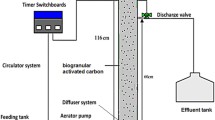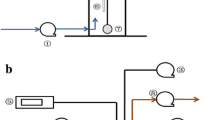Abstract
A laboratory-scale anaerobic sequencing batch reactor (ASBR) was used to pretreat coking wastewater. Inoculated anaerobic granular biomass was acclimated for 225 d to the coking wastewater, and then the biochemical methane potential (BMP) of the coking wastewater in the acclimated granular biomass was measured. At the same time, some fundamental technological factors, such as the filling time and the reacting time ratio (tf/tr), the mixing intensity and the intermittent mixing mode, that affect anaerobic pretreatment of coking wastewater with ASBR, were evaluated through orthogonal tests. The COD removal efficiency reached 38%~50% in the stable operation period with the organic loading rate of 0.37~0.54 kg COD/(m3·d) at the optimum conditions oftf/tr, the mixing intensity and the intermittent mixing mode. In addition, the biodegradability of coking wastewater distinctly increased after the pretreatment using ASBR. At the end of the experiment, the microorganism forms on the granulated sludge in the ASBR were observed using SEM (scanning electron microscope) and fluoroscope. The results showed that the dominant microorganism on the granular sludge was Methanosaeta instead of Methanosarcina dominated on the inoculated sludge.
Similar content being viewed by others
References
American Public Health Association, 1992. Standard Methods for the Examination of Water and Wastewater, 18th Ed. American Public Health Association, Washington, DC.
Dague, R.R., McKinney, R.E., Pfeffer, J.T., 1966. Anaerobic activated sludge.Journal of the Water Pollution Control Federation,38:220–226.
Dague, R.R., McKinney, R.E., Pfeffer, J.T., 1970. Solids retention in anaerobic waste treatment systems.Journal of the Water Pollution Control Federation,42(2):29–46.
Dague, R.R., Habben, C.E., Pidaparti, S.R., 1992. Initial studies on the anaerobic sequencing batch reactor.Water Science and Technology,26(9–11):2492–2432.
Ganczarczyk, J.J., 1972. Second stage activated sludge treatment of coke-plant effluents.Water Research, 7:1137–1157.
Ganczarczyk, J.J., 1980. Fate of Basic Pollutants in Treatment of Coke-Plant Effluents. Proceedings of the 35th Annual Industrial Waste Conference. Purdue University, West Lafayette, IN.
Herum, B.A., Dague, R.R., 1993. Effects of Applied Vacuum on the Performance of the Anaerobic Sequencing Batch Reactor. Proceedings of the 48th Annual Industrial Waste Conference. Purdue University, West Lafayette, IN.
Huang, X., Chen, G., Shao, L.G., Qian, Y., 1995. Coke-plant wastewater treatment by immobilized acclimated bacteria.Fuel and Energy Abstract,36(6):458.
Li, Y.M., Gu, G.W., Zhao, J.F., Yu, H.Q., 2001. Anoxic degradation of nitrogenous heterocyclic compounds by acclimated activated sludge.Process Biochemistry,37(1):81–86.
Li, Y.M., Gu, G.W., Zhao, J.F., Yu, H.Q., Qiu, Y.L., Peng, Y.Z., 2003. Treatment of coke-plant wastewater by biofilm systems for removal of organic compounds and nitrogen.Chemosphere,52:997–1005.
Oven, W.F., Stuckey, D.C., Healy, J.B., Young, L.Y., McCarty, P.L., 1979. Bioassay for monitoring biochemical methane potential and anaerobic toxicity.Water Research,13:485–492.
Rodrigues, J.A.D., Ratusznei, S.M., Camargo, E.F.M., Zaiat, M., 2003. Influence of agitation rate on the performance of an anaerobic sequencing batch reactor containing granulated biomass treating low-strength wastewater.Advances in Environmental Research,7:405–410.
Sekiguchi, K., Kamagata, Y., Nakamura, K., 1999. Fluorescence in situ hybridization using 16s rRNA-targeted oligonucleotides reveals localization of methanogens and selected uncultured bacteria in mesophilic and thermophilic sludge granules.Applied Environmental Microbiology,65(3):1280–1288.
Sotton, P.M., Huvid, J., Hoeksema, M., 1999. Biological fluidized-bed treatment of wastewater from byproduct coking operation: full-scale case history.Journal of the Warter Pollution Control Federation,71:5–9.
Speece, R.E., McCarty, P.L., 1964. Nutrient requirements and biological solids accumulation in anaerobic digestion.Water Pollution Research,2:305–322.
Sung, S., Dague, R.R., 1992. Fundamental Principles of the Anaerobic Sequencing Batch Reactor. Proceedings of the 47th Annual Industrial Waste Conference. Purdue University, West Lafayette, IN.
Sung, S., Dague, R.R., 1995. Laboratory studies on the anaerobic sequencing batch reactor.Water Environment Research,67(3):294–301.
Suthaker, S., Polprasert, C., Droste, R.L., 1991. Sequencing batch anaerobic reactors for treatment of a highstrength organic wastewater.Water Science and Technology,23(7–9):1249–1257.
Tian, Y.J., 2001. The Study of Technology Characteristic of Anaerobic Sequencing Batch Reactor (ASBR). MS Thesis, Taiyuan University of Technology, China (in Chinese).
Timur, H., Özturk, I., 1997. Anaerobic treatment of leachate using sequencing batch reactor and hybrid bed filter.Water Science and Technology,36(6–7):501–508.
Timur, H., Özturk, I., 1999. Anaerobic sequencing batch reactor treatment of landfill leachate.Water Research,33(15):3225–3230.
Wang, J.L., Quan, X.C., Wu, L.B., Qian, Y., Werner, H., 2002. Bioaugmentation as a tool to enhance the remoyal of refractory compound in coke plant wastewater.Process Biochemistry,38:777–781.
Wen, Y.B., Zhang, M., Qian, Y., 1991. Biological treatment of coke-plant wastewater for COD and NH3-N removal.Water Science and Technology,23(6):1883–1892.
Wirtz, R.A., Dague, R.R., 1996. Enhancement of granulation and start-up in the anaerobic sequencing batch reactor.Water Environment Research,68(5):883–892.
Wu, W.M., Jain, M.K., Zeikus, J.G., 1996. Formation of fatty acid-degrading anaerobic granules by defined species.Applied Environmental Microbiology,62(6):2037–2044.
Yu, H.Q., Gu, G.W., Song, L.P., 1997. Posttreatment of effluent from coke-plant wastewater treatment system in sequencing batch reactors.Journal of Environment Engineering,123:305–308.
Zaiat, M., Rodrigues, J.A.D., Ratusznei, S.M., Camargo, E.F.M., Borzani, W., 2001. Anaerobic sequencing batch reactors for wastewater treatment: a developing technology.Appl. Microbiol. Biotechnol.,55:29–35.
Zhang, M., Tay, J.H., Qian, Y, Gu, X.S., 1998. Coke plant wastewater treatment by fixed biofilm system for COD and NH3-N removal.Water Research,32(2):519–527.
Author information
Authors and Affiliations
Corresponding author
Additional information
Project (No. 40272108) supported by the National Natural Science Foundation of China
Rights and permissions
About this article
Cite this article
Li, B., Sun, Yl. & Li, Yy. Pretreatment of coking wastewater using anaerobic sequencing batch reactor (ASBR). J Zheijang Univ Sci B 6, 1115–1123 (2005). https://doi.org/10.1631/jzus.2005.B1115
Received:
Accepted:
Published:
Issue Date:
DOI: https://doi.org/10.1631/jzus.2005.B1115




